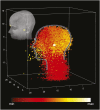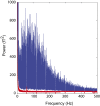Noninvasive muscle activity imaging using magnetography
- PMID: 32071237
- PMCID: PMC7060738
- DOI: 10.1073/pnas.1913135117
Noninvasive muscle activity imaging using magnetography
Abstract
A spectroscopic paradigm has been developed that allows the magnetic field emissions generated by the electrical activity in the human body to be imaged in real time. The growing significance of imaging modalities in biology is evident by the almost exponential increase of their use in research, from the molecular to the ecological level. The method of analysis described here allows totally noninvasive imaging of muscular activity (heart, somatic musculature). Such imaging can be obtained without additional methodological steps such as the use of contrast media.
Keywords: magnetocardiography; magnetoencephalography; magnetomyograph; precise frequency-pattern analysis.
Copyright © 2020 the Author(s). Published by PNAS.
Conflict of interest statement
The authors declare no competing interest.
Figures






References
-
- Chella F., et al. , The impact of improved MEG-MRI co-registration on MEG connectivity analysis. Neuroimage 197, 354–367 (2019). - PubMed
-
- Clarke J., Lee Y.-H., Schneiderman J., Focus on SQUIDs in biomagnetism. Supercond. Sci. Technol. 31, 080201 (2018).
-
- Wijesinghe R. S., Magnetic measurements of peripheral nerve function using a neuromagnetic current probe. Exp. Biol. Med. (Maywood) 235, 159–169 (2010). - PubMed
Publication types
MeSH terms
LinkOut - more resources
Full Text Sources

